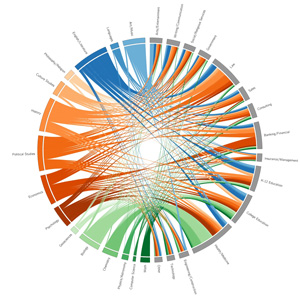
When we talk about digital media, we do not refer to just the direct transfer of one mode of expression (e.g., textual, visual, etc.) by digital means as in an eBook or a YouTube video. There are entirely new genres of communication that are impossible, as such, by analogue means. Consider this graphic, for example:
Impact of Major on Career Path for 15600 Williams College Alums
 Click the image at right to see the full graph or go to:
Click the image at right to see the full graph or go to:
- http://www.williams.edu/feature-stories/visualizing-the-liberal-arts/
- http://web.williams.edu/Mathematics/devadoss/careerpath.html
(Author's Description) This work with Hayley Brooks, Scott Sanderson, and Kaison Tanabe, using the CIRCOS software at its core, has motivated the formation of CereusData. The left side of the circle is broken into 15 parts, each representing a grouping of all majors available at Williams. For example, "Cultural Studies" includes such majors as Anthropology, Sociology, and Asian Studies. The right side of the circle is similarly broken into 15 parts, each representing a grouping of possible careers chosen by Williams alums.

Source: https://usergeneratededucation.wordpress.com/2015/01/31/questions-to-ask-oneself-while-designing-learning-activities/

Source: www.opencolleges.edu.au/informed/features/when-not-to-use-technology-15-things-that-should-stay-simple-in-education

The close interconnection between learning, media, and technology is not a new development. As a matter of fact, according to sociocultural learning theorists like L.S. Vygotsky[1], if we consider human communication as media and the use of tools and technology, then media and technology in their various forms are functionally inseparable from learning. We could argue then that computing and the Internet have not changed the fundamental relationship between the instrumental and intellectual aspects of the mind. Instead, they have highlighted that relationship in an unprecedented way.
In light of this, the collective response of higher education to the "digital" rediscovery of learning as mediated can be overwhelming. The use of information technology and digital media in the classroom has been described in equally positive and negative terms as disruptive, inescapable, unavoidable, revolutionary, transformative, modernizing, and so on. The topic is certainly a controversial one, but the controversy is not as much about whether it is the positive or negative assessments that are correct. Rather, the issue is that all of these assessments can be correct, in one way or another, depending on the context.
The use of digital instructional tools by themselves can not guarantee a positive or a negative learning outcome, but neither can other methods. The key to the successful implementation of digital media and technologies in teaching lies in the relationships they help generate between knowledge, learners, and educators. This guide highlights different examples of these relationships, which can revolve around different means or modes of collaboration, new approaches for instruction and assessment, or wide range of digitally-mediated projects and other learning activities.
[1]Vygotsky, L. S., 1978. Mind in Society: The Development of Higher Psychological Processes. Cambridge, MA: Harvard University Press.
Learning technology can fall on either side of the "traditional" vs. "innovative" educational divide...

Source: http://www.designingculture.net/blog/?p=560
(Anne Balsamo, New School for Public Engagement, NYC)